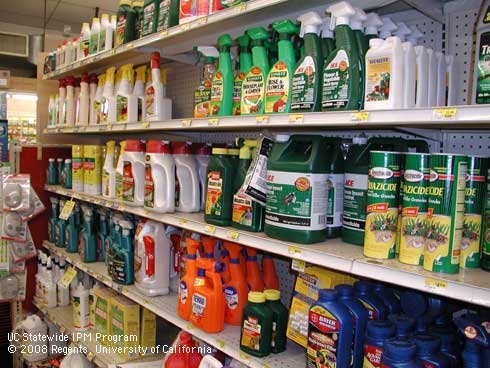[Originally published as “Pesticide Briefs: What Do These Terms Mean?” in the Fall 2018 issue of the Retail Nursery and Garden Center IPM News.]
Last summer, we defined what a pesticide is and gave a few examples. Here, we explore different types of pesticides, their specific uses, and pesticide related terminology.

There are many different types of pesticides, each is meant to be effective against specific pests. The term "-cide" comes from the Latin word "to kill."
- Algaecides are used for killing and/or slowing the growth of algae.
- Antimicrobials and Disinfectants control germs and microbes such as bacteria and viruses.
- Desiccants are used to dry up living plant tissues.
- Defoliants cause plants to drop their leaves.
- Fungicides are used to control fungal problems like molds, mildew, and rust.
- Herbicides kill or inhibit the growth of unwanted plants, aka weeds.
- Insecticides are used to control insects.
- Insect Growth Regulators disrupt the growth and reproduction of insects.
- Miticides control mites that feed on plants and animals. Mites are not insects.
- Molluscicides are designed to control slugs, snails and other molluscs.
- Mothballs are insecticides used to kill fabric pests by fumigation in sealed containers.
- Pheromones are biologically active chemicals used to attract insects or disrupt their mating behavior. The ratio of chemicals in the mixture is often species-specific.
- Plant Growth Regulators are used to alter the growth of plants. For example, they may induce or delay flowering.
- Repellents are designed to repel unwanted pests, often by taste or smell.
- Rodenticides are used to kills rodents like mice, rats, and gophers.
- Synergists make certain pesticides more effective, but they are not effective when used alone.
- Wood Preservatives are used to make wood resistant to insects, fungus and other pests.
Remember, what you do in your home and landscape affects our water and our health. Minimize the use of pesticides that pollute our waterways and harm human health. Use nonchemical alternatives or less toxic pesticide products whenever possible. Be sure to read product labels carefully and follow instructions on proper use, storage, and disposal.
For more information about pesticides, check out the UC IPM Pest Notes: Pesticides: Safe and Effective Use in the Home and Landscape or our Quick Tip on Garden Chemicals: Safe Use & Disposal.
Information courtesy of the National Pesticide Information Center. Modified from the original content.